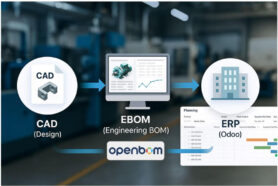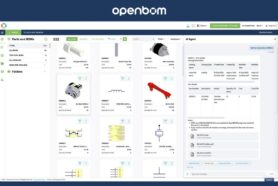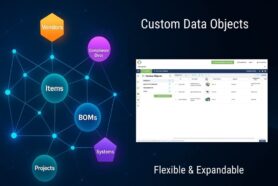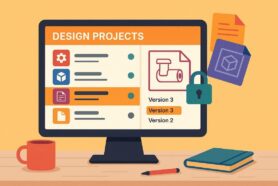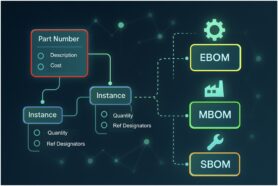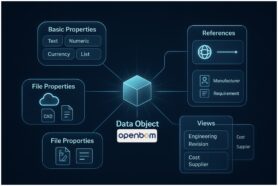
Manufacturing companies are looking at digital transformation as a way of fundamentally changing how businesses operate and manage information. Product design, engineering, research and development, manufacturing, and manufacturing resource planning are key elements of how to streamline processes and make information connected and available to all people inside the organization, including contractors, and suppliers. Bill of Materials is a core element of data management and it is important to keep it aligned during all stages of the product lifecycle management process. Product design, engineering Bill of materials, sales bill of materials, production process, and inventory management – all these processes require BOM functions. Even finished product structure also requires accurate BOM management to support the maintenance process.
While enterprise resource planning (ERP) is usually a center of business transactions for any manufacturing company, there is a lot of information that originated and lives outside of ERP. Taking this data under control, organizing it, and connecting it to ERP is a challenge for many organizations.
In the old times, getting a spreadsheet with a part list and sending it to procurement was a way to run a business. These days are in the past. Companies are looking for seamless information access and synchronization. Documents are not a good way to transfer information. These documents, often mere replicas of traditional paper processes, failed to offer the granular access to information that modern businesses require for efficient planning, collaboration, and analytics.
The emergence of modern cloud technologies and SaaS platforms has transformed this narrative. Companies can now manage, connect, and synchronize data like never before. OpenBOM introduces you to a new way to manage product development in an agile way – agile new product development.
However, the agile product development process doesn’t live in isolation and needs to be integrated with other systems and data sources. In this article, I’d like to share more information about the mechanisms and capabilities OpenBOM offers to seamlessly plan BOM (Bill of Materials) and synchronize this data with ERP systems.
Robust Data Management Mechanism
OpenBOM stands out for its ability to seamlessly connect with a vast array of engineering data. Whether it’s CAD files, cloud-based CAD systems, or any other form of cloud files, OpenBOM extracts all the necessary information. This extraction process facilitates the formation of an engineering BOM (EBOM), replete with all the information required to produce a product.
Item Management and BOM Capabilities
At its core, OpenBOM provides a robust and flexible mechanism to manage items with all attributes and files that are needed. It includes sourcing and vendor management. OpenBOM covers the need to handle multi-sourcing, costing, and other supplier data. OpenBOM streamlines this through its comprehensive item management features. Companies can effortlessly coordinate physical characteristics, tech specs, supplier data, and cost ensuring that every aspect of the engineering and sourcing process, from vendor selection to final product delivery, is accurately managed.
Tightly connected to the Item Management function are BOM management capabilities. OpenBOM helps to capture computer-aided design (CAD) data transferring it into a single-level BOM (or multi-level BOM) with all the components required including all connected files.
OpenBOM Production Planning Functions
OpenBOM provides support for production procurement planning for situations when you cannot use an ERP/MRP system such as small prototype runs or if your company hasn’t decided yet about ERP system use. OpenBOM fills the gap for companies working with CM (contract manufacturers) or provides solutions for prototype development of engineering to order production planning.
OpenBOM’s production planning system is tailor-made for this purpose. Beyond just managing the purchasing process (covering RFQs and Purchase Orders), it facilitates effective coordination with suppliers and contractors. The emphasis here is on planning and execution, ensuring that production schedules are met and resources optimally utilized.
Seamless Data Integration and ERP Sync Capabilities
Once a company decides to use an ERP system, OpenBOM provides multiple technologies and product capabilities to make the ERP synchronization process seamless. It includes REST API, robust out-of-the-box import/export functions, direct integrations with ERP systems, and automated low-code template-based data exchange processes
OpenBOM makes data to follow in both directions from engineering to production (ERP) and back to support a transfer of engineering bill of materials (BOM) information into manufacturing bill (BOM), adding all raw materials and helping to control purchasing and manufacturing process in a seamless way.
Conclusion
Digital BOM is a new way to manage information and processes. It helps you to stop relying on outdated Excel files, sending emails, and realizing at the last moment that an Excel file you sent to procurement or contractor is outdated. You need to have BOM information especially manufacturing BOM with all components and raw materials managed in a digital form to have company business processes optimized for digital business.
OpenBOM is more than just a tool to sync your bill of materials data – it’s an online platform that enables businesses to harness the power of digital transformation fully. From capturing complex CAD and other engineering information to organizing both Engineering and Manufacturing BOMs, from facilitating batch planning to ensuring seamless ERP integration, OpenBOM stands out as a digital partner for companies looking into future digital manufacturing. If you’re looking at how to transform and optimize your product development and ERP processes, it’s time to explore what OpenBOM has to offer.
REGISTER FOR FREE and start a 14-day trial to explore how OpenBOM can help.
Best, Oleg
Join our newsletter to receive a weekly portion of news, articles, and tips about OpenBOM and our community.


